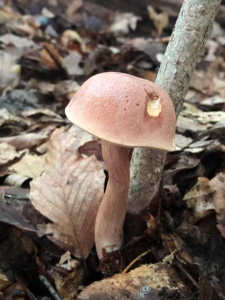By Anthony Goodman, Ph.D.
comment
You may have read this in the last few years trees can communicate with each other via an invisible network of fungi, but what does that mean? trees communicate? That old oak tree Tree your front yard won’t say “Hi” to you when you walk by, and it certainly won’t text you — but it can send chemical messengers through its roots into the vast network of hundreds of fungi, which it’s happy to give the note near further trees, shrubs and even grasses. The fungi aren’t just the mushrooms that pop up after a good rain, but the tiny white, yellow, or orange threads that run through most of the topsoil and perform myriad services in breaking down old plant matter and creating fresh soil. These cobweb-looking threads are actually the body of the fungus, which can range from inches to miles across in extreme cases.
Submitted photo
Many of these fungi have developed special relationships with plants, in which these fibers, called mycelium, envelop or even penetrate the root trees, shrubs and just about anything with roots and home decor. At this crossing, they exchange water for the plant’s sugars. This interaction is called the mycorrhizal relationship. The mycelium is much thinner and wider than itself TreeRoots and can absorb a lot of water, but they desperately want what the plant makes and they can’t – energy in the form of sugars and carbohydrates. These relationships continue as many fungi can attract, trap and digest small bugs like springtails and nematodes, trading vital nitrogen for even more sugar! In addition, they help mycorrhizal plants become more resistant to disease, since fungi can act like an external immune system, eliminating bacteria and pests before they reach the plant. This symbiotic relationship helps both plants and fungi thrive where they otherwise would not thrive. In fact, many plants and fungi cannot grow to maturity without a mate. These relationships have gone so far that some trees need a specific subset of mushrooms to grow, and some mushrooms cannot grow without their specialty Tree Friends! Orchids cannot even germinate without their mycorrhizal partners. For this reason, most soil mixes are actually pre-seeded with known beneficial fungi (see it on the next bag of potting soil you buy!).
Okay, so fungi are pretty much everywhere in the soil and have plant friends, but what about communication? Not only do plants emit buckets of sugar to keep the fungi happy, they also emit chemical messengers all the time. These chemicals (just small organic molecules) are a kind of diagnosis of the Tree – some might mean that Tree gets plenty of sun while others indicate an insect infestation. These signals are passed from one plant to another by the fungi, allowing the other plants to open their leaves a little more for the sun or to strengthen their defenses against insect infestation. This underground, forest-wide web allows plants, even different species, to work as a community simply by letting their neighbors know how they’re doing. That means, in a way, that trees actually chatting about the weather, gossiping about their pest-infested neighbors, or even encouraging their young to grow. In some cases, the fungi are even tasked with storing sugars, nitrogen, and other vital nutrients for new plants in the neighborhood as the local environment changes—all to keep the community healthy, happy, and prosperous even during times of transition .
Who knew mycorrhizal relationships had such wisdom to share? I wonder what we’ll learn the next time we tap into the Wood-Wide Web?
dr Goodman recently published the book Edible Wild Mushroom Search and Identification Presented by the Alabama Mushroom Society.
www.trussvilletribune.com
https://www.trussvilletribune.com/2023/04/12/tree-talk-wood-wide-web/













